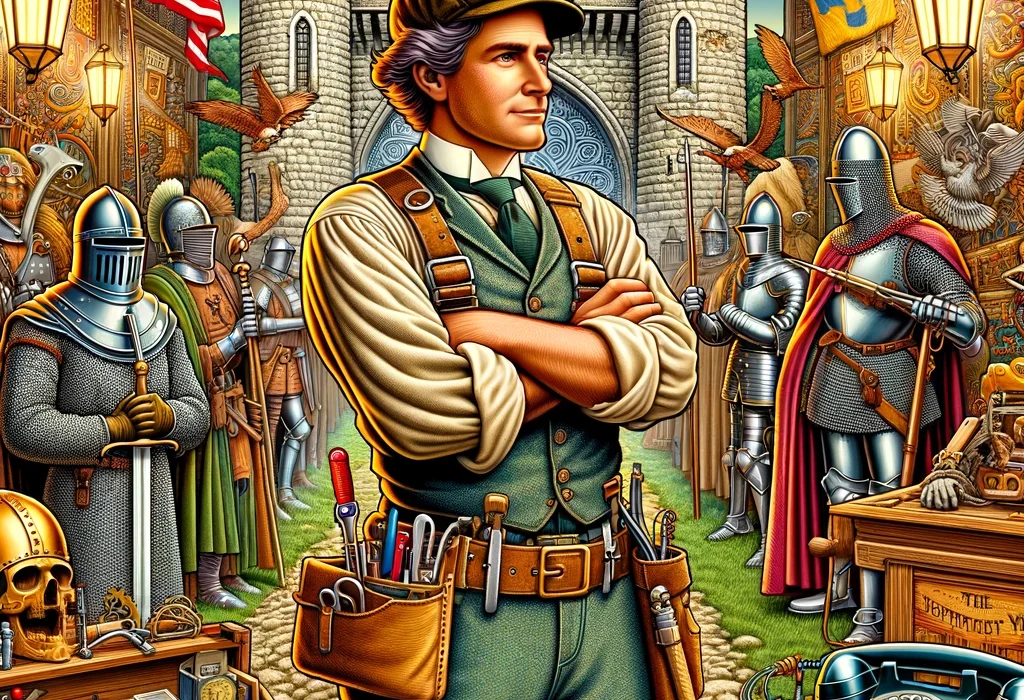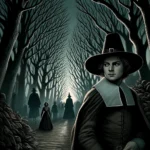A Connecticut Yankee in King Arthur’s Court, written by Mark Twain and published in 1889, is a satirical novel blending science fiction and historical fantasy. The book tells the tale of Hank Morgan, a 19th-century American who is transported back in time to the court of King Arthur. Twain uses humor and sharp social commentary to critique romanticized views of medieval Europe, as well as to explore contemporary issues such as the abuse of power, superstition, and the dangers of an uncritical society.
Plot Summary
In the grand halls of Camelot, where the air is thick with chivalric ideals and the rigid traditions of knighthood, a man named Hank Morgan finds himself utterly out of place. A practical-minded engineer from 19th-century Connecticut, Hank wakes up in a world of swords and sorcery, sent back in time after a violent blow to the head. The year is 528 A.D., and King Arthur reigns over a land of castles, knights, and myths. It’s a time that reveres superstition and despises innovation, a stark contrast to Hank’s own world, which thrives on logic, technology, and industry.
At first, Hank is bewildered, not by the court’s opulence or its legendary figures but by how easily people accept the supernatural. When he is arrested as an intruder and hauled before King Arthur, Hank quickly realizes that this isn’t some dream. The medieval mind perceives him as a foreigner or possibly even a sorcerer. Sentenced to be burned at the stake by the court’s so-called wise man, Merlin, Hank must think quickly to avoid death.
Hank recalls that a solar eclipse is set to occur the very next day. Armed with this knowledge, he convinces the people of Camelot that he wields immense magical power, claiming he can blot out the sun. As the sky darkens and panic spreads, Hank solidifies his status as a wizard greater than Merlin, who is left to sulk in defeat. Arthur grants Hank his freedom, and soon, he becomes the king’s right-hand man, known to the people as “The Boss.”
Now in a position of influence, Hank begins to modernize the medieval world with the wonders of 19th-century science and technology. He sets up schools, factories, and even telegraph lines, turning Camelot into a burgeoning industrial society. However, while Hank marvels at his accomplishments, he quickly realizes that progress in this world comes at a cost. The rigid social hierarchy doesn’t crumble as easily as the old traditions of superstition, and Hank is often reminded that no amount of technological advancement can easily change the hearts of the powerful or the oppressed.
As Hank consolidates his power, his friendship with Clarence, a bright young boy, blossoms. Clarence becomes Hank’s confidante, assisting him in his quest to transform Camelot into a modern society. Together, they embark on various adventures, during which Hank’s knowledge of firearms, electricity, and mechanical engineering continually astounds the knights and common folk alike.
On one of these adventures, Hank is accompanied by a lady named Sandy, who insists that Hank help her rescue a group of maidens held captive by “ogres.” Hank, amused by her archaic manner and outlandish descriptions, plays along. But when they arrive, they discover that the “ogres” are nothing more than poor, mistreated pig farmers. The incident reinforces Hank’s disdain for the ignorance of the medieval world, but it also deepens his sympathy for the common people who suffer under the weight of nobility and myth.
Despite Hank’s best efforts, the darker aspects of the era continue to challenge him. The clergy and nobility, represented by figures like Merlin, view his inventions and ideas as threats to their power. They conspire against him, believing that the old ways must be preserved at all costs. Merlin, especially, loathes Hank and continues to claim his magical superiority, though his tricks seem primitive compared to Hank’s real-world knowledge.
In a pivotal moment, Hank and King Arthur, disguised as peasants, set out on a journey to experience the lives of the common folk. Along the way, they witness firsthand the extreme poverty and cruelty that defines the medieval social order. Arthur, who has long ruled from his ivory tower, is deeply moved by the suffering of his people. However, when they are captured and sold as slaves, the journey takes a grim turn. Hank’s technological prowess cannot save them from the brutality of the system they’ve been working to reform. They are only rescued by Clarence and Hank’s soldiers at the last possible moment.
The tide begins to turn against Hank as his technological advancements disrupt the fragile balance of medieval life. The church and the aristocracy band together, fanning the flames of superstition and fear. Hank’s factories and innovations are seen as symbols of rebellion, and war soon breaks out between those loyal to Hank’s vision of progress and those clinging to the past.
As the conflict escalates, Hank retreats to Merlin’s cave, where he prepares for a final stand. He constructs an arsenal of modern weapons, hoping to defeat the medieval armies that seek to destroy him. With only a small band of loyalists, including Clarence, Hank fights against overwhelming odds. His technological marvels—machine guns and electric fences—decimate the enemy forces. The battlefield becomes a graveyard, filled with knights in shining armor who never stood a chance against Hank’s machines of war.
But victory is hollow. Camelot is in ruins, its population decimated. As Hank and his few remaining allies contemplate their grim future, Merlin emerges one last time. The old wizard, whose power Hank has scoffed at throughout his time in Camelot, casts a spell that puts Hank into a deep sleep. When Hank awakens, the medieval world he sought to change is gone, and so is his influence.
Lying on his deathbed in his own time, Hank Morgan reflects on his experience in Camelot. His attempt to bring modernity to the Dark Ages has ended in tragedy, a reminder that even the most well-intentioned efforts at progress can be fraught with unintended consequences.
Main Characters
- Hank Morgan: The protagonist, a practical and resourceful man from 19th-century Connecticut who, after being hit on the head, wakes up in the sixth century at King Arthur’s court. He uses his knowledge of modern technology and science to manipulate the medieval world and ascend to power.
- King Arthur: The legendary monarch of Camelot, depicted as noble yet somewhat naïve. Arthur represents the chivalric ideals of the time but is often manipulated by those around him.
- Merlin: The fabled wizard of Arthur’s court, who is portrayed as a charlatan clinging to outdated beliefs in magic. He becomes one of Hank’s chief antagonists.
- Clarence: A young boy who becomes Hank’s loyal friend and assistant. Clarence represents the youthful innocence of the time but learns to navigate the complexities of court life under Hank’s guidance.
- Sandy: A maiden who speaks in the elaborate and flowery language of the period. She becomes Hank’s companion during a journey, and her quaint demeanor provides comic relief.
Theme
- Technology vs. Tradition: Hank’s introduction of 19th-century technology to the medieval world contrasts sharply with the old-world customs, illustrating Twain’s critique of blind adherence to tradition.
- Power and Corruption: The novel explores how those in power, such as Merlin and other nobility, manipulate the masses through superstition and deceit. Hank’s rise to influence through knowledge rather than birthright comments on the nature of leadership and authority.
- Class Inequality: Twain highlights the stark class divisions of medieval society, with the suffering of peasants contrasting the luxury and folly of the nobility. Hank’s democratic ideals challenge the rigid feudal system.
- Satire of Romanticism: Through Hank’s practical American outlook, Twain satirizes the romanticized version of knighthood, chivalry, and the Middle Ages popularized in 19th-century literature.
Writing Style and Tone
Mark Twain’s writing in A Connecticut Yankee in King Arthur’s Court combines sharp wit with poignant social commentary. His tone is often humorous, particularly in Hank’s observations about the absurdities of Arthurian legend and the superstitions of the time. The first-person narrative allows readers to see the medieval world through Hank’s practical and often sarcastic perspective, which reinforces Twain’s critique of both medieval and contemporary society.
Twain’s use of language is deliberately anachronistic, mixing archaic terms with modern idioms, reflecting Hank’s struggle to fit into a world that is both alien and backward. This juxtaposition of styles emphasizes the absurdity of certain traditions and highlights the novel’s central tension between progress and nostalgia.
We hope this summary has sparked your interest and would appreciate you following Celsius 233 on social media:
There’s a treasure trove of other fascinating book summaries waiting for you. Check out our collection of stories that inspire, thrill, and provoke thought, just like this one by checking out the Book Shelf or the Library
Remember, while our summaries capture the essence, they can never replace the full experience of reading the book. If this summary intrigued you, consider diving into the complete story – buy the book and immerse yourself in the author’s original work.
If you want to request a book summary, click here.
When Saurabh is not working/watching football/reading books/traveling, you can reach him via Twitter/X, or LinkedIn.
Restart reading!








